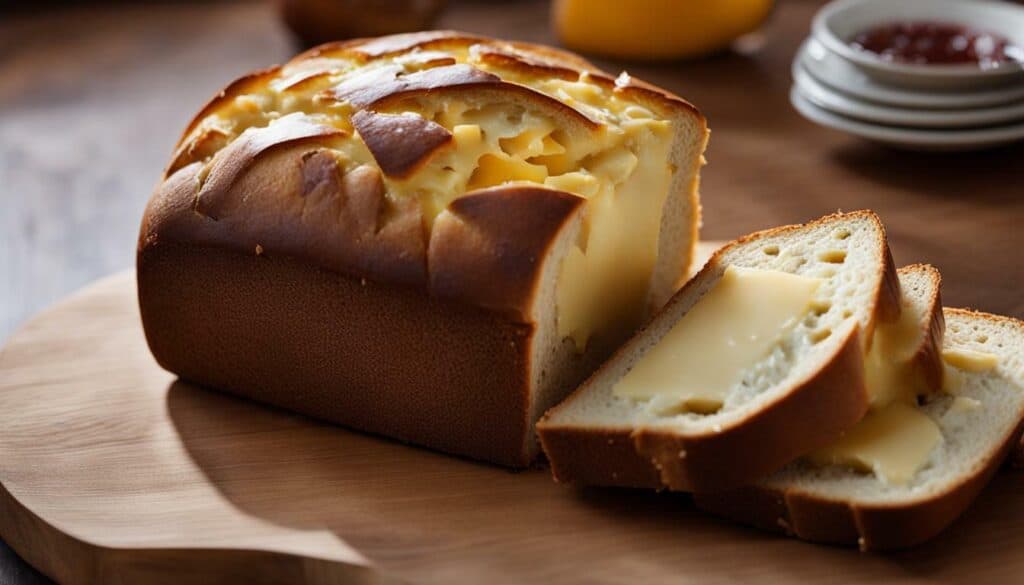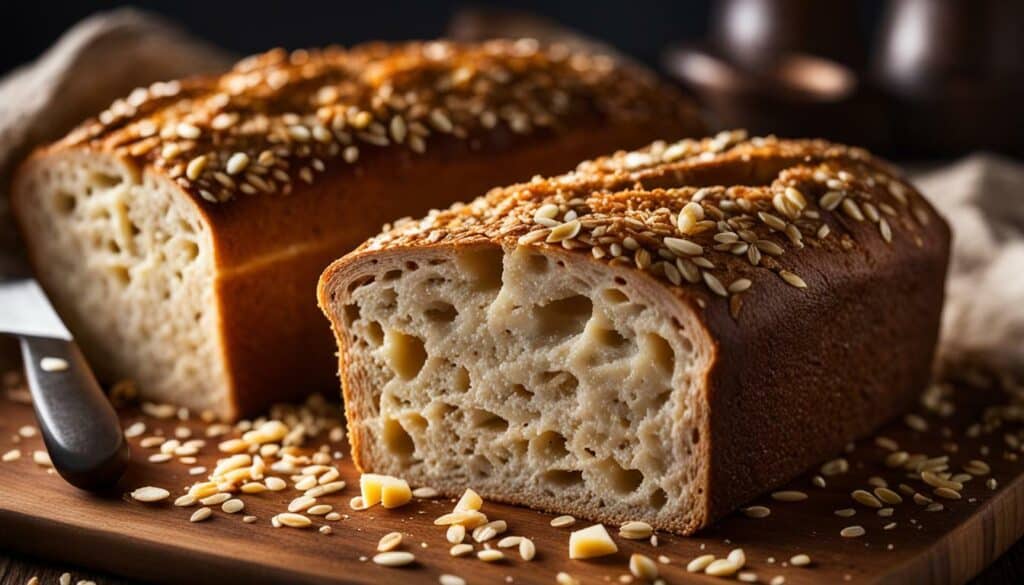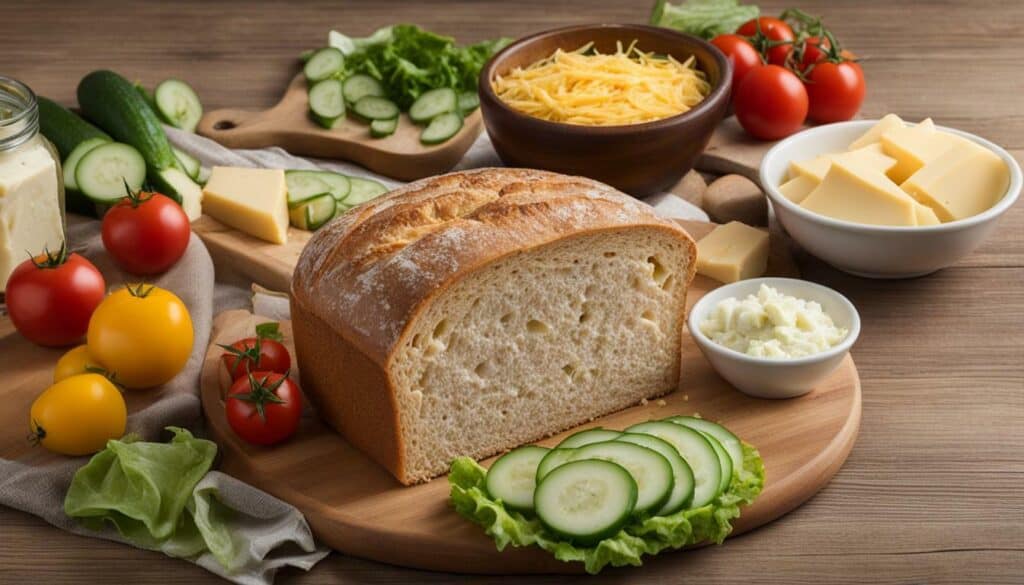Are you curious about the calorie count in your favorite bread with cheese snack? It’s important to be mindful of your calorie intake, especially if you’re conscious about maintaining a healthy diet. Thankfully, there are various sources available that provide detailed nutritional information for different types of bread snacks, including those with cheese.
One such source offers comprehensive nutrition facts for cheese bread snacks, providing information on calories, fat, saturated fat, cholesterol, sodium, carbohydrates, net carbs, sugar, fiber, protein, and a range of vitamins and minerals. This information can help you make informed choices about the nutritional content of your favorite bread with cheese snack.
Additionally, if you prefer homemade bread, there are resources that explain how to calculate the calorie count in your own baked bread. They emphasize the importance of weighing the ingredients accurately and determining the calorie content based on the weight of the final product. This attention to detail ensures that you have an accurate understanding of the calorie count in your homemade bread with cheese snack.
To make your bread with cheese snack even healthier, consider the following tips. Opt for whole grain bread, which offers superior nutritional benefits compared to refined white bread. Choose low-sodium lunch meats to reduce your sodium intake. Don’t forget to add plenty of vegetables to boost the nutritional value and add flavor to your sandwich. Lastly, utilize low-calorie spreads like mustard or relish for a healthier alternative to high-calorie options.
Key Takeaways:
- Discovering the calorie count in your bread with cheese snack is crucial for those mindful of their calorie intake.
- Various sources provide detailed nutritional information for different types of bread with cheese snacks.
- Consider using homemade bread and accurately calculating the calorie count based on ingredient weights for precise results.
- Choose whole grain bread, low-sodium lunch meats, ample vegetables, and low-calorie spreads for healthier sandwich options.
- By making informed choices, you can enjoy your bread with cheese snack while still being mindful of your nutritional goals.
Counting calories is an essential aspect of managing your diet and ensuring you maintain a healthy weight. By keeping track of the number of calories you consume each day, you can make informed decisions about your food choices and maintain a balanced and nutritious diet. When it comes to bread with cheese snacks, understanding the calorie count is particularly important.
Knowing how many calories are in your bread with cheese snack allows you to adjust your portion sizes and make substitutions if necessary. Different types of bread and cheese can vary significantly in calorie content, so it’s essential to be aware of the specific nutritional information for the products you are consuming. This knowledge empowers you to make healthier choices and control your calorie intake more effectively.
To accurately calculate the calories in your bread with cheese snack, it’s crucial to consult reliable sources for nutrition information. You can find detailed nutrition facts for various bread snacks, including the calorie count, fat content, carbohydrates, and other essential nutrients. By utilizing these resources, you can make more informed decisions about your snacking habits and strive towards a balanced and nutritious diet.

| Bread Type | Cheese Type | Calories |
|---|---|---|
| Whole Wheat | Cheddar | 150 |
| White | Swiss | 180 |
| Multi-Grain | Pepper Jack | 160 |
By referencing the nutrition facts and utilizing resources to calculate the calorie count in your bread with cheese snack, you can make more informed choices about your diet. Remember, every calorie counts, and being mindful of your intake is vital for maintaining a healthy weight and overall well-being.
Understanding the Nutrition Facts of Cheese Bread
To make informed dietary choices, it’s crucial to understand the nutrition facts and macros found in cheese bread. This popular snack combines the savory goodness of cheese with the satisfying taste of bread, making it a favorite among many. Let’s take a closer look at the nutritional content of cheese bread and how it can fit into a balanced diet.
When it comes to cheese bread, the exact nutrition facts may vary depending on the ingredients and portion size. However, as a general guideline, cheese bread typically contains calories, fat, saturated fat, cholesterol, sodium, carbohydrates, net carbs, sugar, fiber, protein, and various vitamins and minerals.
For individuals monitoring their calorie intake, it’s important to note that cheese bread can be relatively high in calories due to the combination of cheese and bread. It’s recommended to enjoy cheese bread in moderation, savoring it as a treat rather than a daily staple. Pairing it with healthier options like a side of fresh vegetables or a low-calorie spread can help balance out its calorie content.

In summary, understanding the nutrition facts and macros of cheese bread can help you make informed decisions about your dietary choices. While cheese bread can be a delicious snack, it’s essential to enjoy it in moderation as part of a well-rounded diet. By incorporating healthier ingredients and mindful portion control, you can still savor the delectable combination of cheese and bread while maintaining a balanced approach to your overall nutrition.
Calculating the Calorie Count in Homemade Bread
If you enjoy making your own bread, knowing how to calculate the calorie count can help you maintain control over your daily intake. By accurately measuring your ingredients and taking into account the nutritional information of each component, you can have a clear understanding of the calorie content in your homemade bread with cheese snacks.
One important step in calculating the calorie count is weighing each ingredient. By using a kitchen scale to measure the exact weight of your flour, cheese, and other ingredients, you can ensure accuracy in your calculations. Remember to account for the weight of the final baked bread, as this will determine the calorie content per serving.
There are several online resources that provide detailed information on the calorie count and macronutrient composition of various ingredients. These resources can help you find the specific nutritional information for the type of bread and cheese you are using in your recipe. By adding up the calories from each ingredient and dividing by the number of servings, you can determine the calorie count per serving of your homemade bread with cheese snack.
Calculating the Calorie Count in Homemade Bread
| Ingredient | Weight (grams) | Calories |
|---|---|---|
| Flour | 200 | 700 |
| Cheese | 50 | 200 |
| Other Ingredients | 100 | 300 |
| Total | 350 | 1200 |
Based on the example above, if your homemade bread with cheese snack weighs 350 grams in total and contains 1200 calories, you can calculate that each 100-gram serving of your snack will have approximately 343 calories. This information can be useful for those who are monitoring their calorie intake and looking to make informed choices about their daily nutrition.

By taking the time to calculate the calorie count in your homemade bread with cheese snack, you can have a better understanding of its nutritional value and make adjustments to fit your dietary needs. Whether you are trying to lose weight, maintain a healthy lifestyle, or simply be more mindful of your calorie intake, knowing the specific calorie count of your homemade bread can be a valuable tool in achieving your goals.
Tips for Making Healthier Sandwiches
Creating healthier sandwiches doesn’t mean sacrificing on taste – it’s all about making smart ingredient choices and using low-calorie spreads. By opting for nutritious alternatives and incorporating vibrant flavors, you can elevate your bread with cheese snack into a satisfying and health-conscious meal. Here are some tips to help you make delicious and nutritious sandwiches:
1. Choose Whole Grain Bread
Start by selecting whole grain bread as the foundation for your sandwich. Whole grains are rich in fiber, vitamins, and minerals, providing essential nutrients for a well-rounded meal. Look for labels that mention “100% whole grain” or “whole wheat” to ensure you’re getting the most nutritional benefits.
2. Opt for Low-Sodium Lunch Meats
When it comes to choosing sandwich fillings, opt for low-sodium lunch meats. High sodium intake is linked to various health concerns, so selecting low-sodium options helps to reduce your overall sodium intake while still enjoying the savory flavors of your sandwich. Look for labels that indicate low sodium content or consider cooking and slicing your own lean meats for a healthier alternative.
3. Add Plenty of Vegetables
To boost the nutritional value of your sandwich, add plenty of vegetables. Not only do these colorful additions provide essential vitamins and minerals, but they also add delicious crunch and texture. Load up your sandwich with fresh lettuce, juicy tomatoes, crisp cucumbers, and other favorite veggies for a satisfying and nutrient-packed meal.
4. Utilize Low-Calorie Spreads
Finally, choose low-calorie spreads to add flavor without adding excessive calories. Mustard, salsa, hummus, and relish are all fantastic options that provide a burst of taste without compromising your health goals. These spreads can enhance the overall flavor profile of your sandwich while keeping the calorie count in check.
By incorporating these tips into your sandwich-making routine, you can enjoy a healthier and more balanced bread with cheese snack. Remember, it’s all about making informed choices and finding delicious alternatives that align with your nutritional goals.
| Sandwich Filling | Calories (per serving) |
|---|---|
| Cheddar Cheese | 110 |
| Turkey Breast | 50 |
| Tomato | 15 |
| Lettuce | 5 |
| Mustard | 0 |
Choosing Whole Grain Bread for Nutritional Benefits
Whole grain bread is a nutritious choice for your bread with cheese snack, offering numerous benefits for your overall health. Unlike refined white bread, which has been stripped of its bran and germ, whole grain bread is made from the entire grain, maintaining its natural goodness. It is rich in fiber, vitamins, minerals, and antioxidants that are essential for a well-balanced diet.
When compared to white bread, whole grain bread contains more fiber, which aids in digestion and helps keep you feeling fuller for longer. This can be particularly beneficial if you are trying to manage your weight or maintain a healthy eating plan. Whole grain bread also has a lower glycemic index, meaning it causes a slower and steadier rise in blood sugar levels, making it a suitable choice for individuals with diabetes or those looking to control their blood sugar levels.
Additionally, whole grain bread is a great source of nutrients such as B vitamins, iron, zinc, and magnesium. These nutrients play vital roles in promoting energy production, supporting a healthy immune system, and maintaining proper brain function. They also help to keep your skin, hair, and nails healthy and vibrant.
| Nutrients | Whole Grain Bread (1 slice) | % Daily Value* |
|---|---|---|
| Fiber (g) | 3.5 | 14% |
| Iron (mg) | 0.9 | 5% |
| Thiamin (mg) | 0.2 | 13% |
| Niacin (mg) | 2.0 | 10% |
| Magnesium (mg) | 23.5 | 6% |
| Zinc (mg) | 0.8 | 5% |
So, next time you indulge in a delicious bread with cheese snack, consider opting for whole grain bread. Not only will you enjoy its wholesome taste and texture, but you’ll also be nourishing your body with essential nutrients that support your overall well-being.

Opting for Low-Sodium Lunch Meats
Low-sodium lunch meats are a smart choice when it comes to creating healthier sandwiches without compromising flavor. These deli meats, which have reduced sodium content compared to their regular counterparts, offer a great alternative for those looking to cut back on their salt intake. By opting for low-sodium lunch meats, you can still enjoy the convenience and taste of deli meats while making a healthier choice for your sandwich.
When selecting low-sodium lunch meats, be sure to check the nutrition labels for sodium content. Look for options that contain around 140 milligrams or less of sodium per serving. This will help you stay within the recommended daily limit of sodium, which is 2,300 milligrams for most adults. By reducing your sodium intake, you can help manage your blood pressure and reduce the risk of heart disease.
In addition to being lower in sodium, these meats also offer a good source of protein, making them a nutritious addition to your sandwich. They come in a variety of options, including turkey, chicken, ham, and roast beef. Pairing low-sodium lunch meats with whole grain bread, fresh vegetables, and low-calorie spreads can help create a delicious and wholesome sandwich that is both satisfying and nourishing.
By choosing low-sodium lunch meats, you can enjoy the taste of deli meats while making a healthier choice for your sandwich. With the wide variety of options available, you can create a sandwich that suits your tastes and dietary needs. So next time you’re assembling a sandwich, remember to reach for low-sodium lunch meats for a smart and flavorful choice.
Low-Sodium Lunch Meats Comparison Table
| Meat Type | Serving Size | Calories | Total Fat (g) | Sodium (mg) |
|---|---|---|---|---|
| Turkey Breast | 1 slice (28g) | 30 | 1 | 130 |
| Chicken Breast | 1 slice (28g) | 25 | 0.5 | 120 |
| Ham | 1 slice (28g) | 35 | 2 | 140 |
| Roast Beef | 1 slice (28g) | 60 | 2.5 | 160 |
Source: nutritionfacts.com
Adding Plenty of Vegetables to Boost Nutrition
Vegetables are a fantastic addition to your bread with cheese snack, providing essential vitamins and minerals while adding a delightful crunch. Including a variety of colorful vegetables in your sandwich not only enhances its nutritional value but also adds interesting flavors and textures. Here are some vegetables you can consider adding to your bread with cheese snack:
- Spinach: Packed with iron and vitamin K, spinach adds a refreshing taste to your sandwich. It pairs well with both mild and sharp cheeses, adding a hint of earthiness.
- Tomatoes: Bursting with antioxidants and vitamin C, tomatoes bring a juicy tang to your sandwich. Whether thinly sliced or in the form of a flavorful sun-dried tomato spread, they complement cheese beautifully.
- Cucumbers: With their high water content, cucumbers provide hydration and a cool crunch. They are a great choice for balancing the richness of cheese in your snack.
- Red bell peppers: Sweet and crisp, red bell peppers are packed with vitamin C and antioxidants. They add a vibrant flavor and a satisfying crunch to your bread with cheese snack.
To further enhance the nutritional value of your sandwich, you can also experiment with other vegetables like shredded carrots, sliced radishes, or even avocado. These additions not only boost the overall nutrition of your snack but also make it visually appealing and satisfying to eat.
Remember, the key to enjoying a healthier sandwich is to have a good balance of flavors, textures, and nutrients. By adding plenty of vegetables to your bread with cheese snack, you can create a delicious and nutritious meal that satisfies your cravings while keeping you on track with your health goals.
Table: Nutritional Value of Common Vegetables
| Vegetable | Calories | Carbohydrates (g) | Fiber (g) | Vitamin C (mg) | Vitamin K (mcg) |
|---|---|---|---|---|---|
| Spinach (1 cup) | 7 | 1 | 1 | 8 | 145 |
| Tomato (1 medium) | 22 | 5 | 1 | 16 | 8 |
| Cucumber (1 cup sliced) | 16 | 4 | 1 | 2 | 71 |
| Red bell pepper (1 medium) | 37 | 9 | 3 | 152 | 9 |
These values are approximate and can vary based on the size and variety of the vegetables. Incorporating a variety of vegetables into your bread with cheese snack not only adds flavor but also ensures a range of essential nutrients to support your overall health.

Low-calorie spreads are an excellent way to add flavor and moisture to your bread with cheese without piling on excess calories. These spreads are often made with lighter ingredients, such as herbs, spices, or low-fat dairy products, providing a tasty alternative to traditional high-fat spreads like mayonnaise or butter. By swapping out higher calorie options with low-calorie spreads, you can enjoy your bread with cheese snack guilt-free.
One popular low-calorie spread option is mustard. Mustard adds a tangy and zesty kick to your bread with cheese, enhancing the overall flavor. It is typically low in calories and fat, making it a healthier choice. Another option is relish, which adds a sweet and tangy taste to your snack. Just make sure to choose relish with no added sugars or artificial sweeteners to keep it low in calories.
For those who prefer a creamier spread, Greek yogurt can be a delicious and low-calorie option. Greek yogurt is high in protein and low in calories, providing a creamy texture and tangy taste without the added fat. You can also experiment with different flavors of Greek yogurt, such as garlic or dill, to add even more variety to your bread with cheese snack.
| Spread Option | Calories per Serving |
|---|---|
| Mustard | 5 |
| Relish | 10 |
| Greek Yogurt | 35 |
Incorporating low-calorie spreads into your bread with cheese snack not only adds flavor but also provides additional nutritional benefits. These spreads are typically lower in saturated fat and can be a good source of protein and other important nutrients. So, next time you enjoy a bread with cheese snack, consider using a low-calorie spread to enhance the taste while keeping the calorie count in check.

Curious about the calorie count of different sandwich fillings and spreads? We’ve got you covered. Whether you’re watching your calorie intake or simply looking for healthier options, knowing the calorie content of your sandwich ingredients is essential. Here are some common sandwich fillings and spreads along with their approximate calorie counts per serving:
| Sandwich Filling/Spread | Calories per Serving |
|---|---|
| Cheddar Cheese | 113 calories |
| Turkey Breast | 50 calories |
| Ham | 46 calories |
| Mayonnaise | 94 calories |
| Mustard | 4 calories |
| Tomato | 29 calories |
| Lettuce | 5 calories |
| Avocado | 234 calories |
These calorie counts are estimates and may vary depending on serving size and brand. It’s always a good idea to check the packaging or use online resources for more accurate information. Remember, portion control is key when it comes to managing your calorie intake. You can also make your sandwiches healthier by opting for whole grain bread, low-sodium lunch meats, and adding plenty of fresh vegetables. And don’t forget to consider low-calorie spreads like mustard or relish instead of high-calorie options like mayonnaise. With these tips and the knowledge of calorie counts, you can create delicious and nutritious sandwiches to enjoy!

As you can see, there are many options to choose from when it comes to sandwich fillings and spreads. The calorie counts provided here can help you make informed decisions about what to include in your bread with cheese snack. Whether you’re counting calories or simply looking to make healthier choices, being aware of the nutritional content of the ingredients you use is essential. Remember to consider portion sizes and to customize your sandwiches to suit your particular dietary needs and preferences. By doing so, you can enjoy a tasty and satisfying bread with cheese snack without compromising your health and wellness goals.
Making Informed Choices for Your Bread with Cheese Snack
Armed with knowledge about the nutritional content and calorie count of bread with cheese, you can make more informed choices that align with your dietary goals. Understanding the nutritional information of your favorite snack allows you to better manage your calorie intake and make healthier decisions.
One source provides detailed nutrition facts for a cheese bread snack, including calories, fat, saturated fat, cholesterol, sodium, carbohydrates, net carbs, sugar, fiber, protein, and various vitamins and minerals. This information empowers you to assess the overall nutritional value of the bread with cheese snack and decide if it fits into your daily calorie and macronutrient goals.
Additionally, you can calculate the calorie count in homemade bread by following a simple process. It involves accurately weighing the ingredients and determining the calorie content based on the final baked bread’s weight. This method ensures precise measurement and helps you track your calorie intake more effectively.

To make your bread with cheese snack even healthier, there are several tips you can follow. Choose whole grain bread, which offers superior nutritional benefits compared to refined white bread. Opt for low-sodium lunch meats to reduce your sodium intake and select lean options for a healthier sandwich. Adding plenty of vegetables to your snack not only boosts its nutritional value but also adds flavor and freshness. Consider using low-calorie spreads such as mustard or relish instead of high-fat options to further reduce calorie intake.
By incorporating these strategies and being aware of the calorie counts for different types of sandwich fillings and spreads, you can enjoy your bread with cheese snack while staying on track with your health and wellness goals. Remember, making informed choices is key to maintaining a balanced and nutritious diet.
Table: Calorie Counts for Sandwich Fillings and Spreads
| Sandwich Filling/Spread | Calories per Serving |
|---|---|
| Cheddar Cheese | 113 |
| Turkey Breast | 50 |
| Ham | 46 |
| Mayonnaise | 90 |
| Mustard | 5 |
| Relish | 20 |
Conclusion
By understanding the calorie count and nutritional information of bread with cheese, you can enjoy this delicious snack while staying in control of your diet. It’s important to be mindful of your calorie intake, especially if you’re trying to maintain a healthy lifestyle. Thankfully, there are various sources available that provide detailed nutrition facts for different types of bread snacks.
One source in particular offers comprehensive information on a popular choice: cheese bread. This source breaks down the nutrition content of this treat, including calories, fat, saturated fat, cholesterol, sodium, carbohydrates, net carbs, sugar, fiber, protein, and various vitamins and minerals. This allows you to make informed decisions about the amount of cheese bread you’re consuming and its impact on your overall diet.
If you’re someone who enjoys baking at home, it’s also crucial to accurately calculate the calorie count of your homemade bread. Another source explains the process for doing so, emphasizing the importance of weighing the ingredients and determining the calorie content based on the weight of the final baked bread. This ensures that you have a precise understanding of the calories you’re consuming in each slice.
To make your bread with cheese snacks healthier, there are several tips you can follow. Choosing whole grain bread over refined options provides superior nutritional benefits, including more fiber and essential nutrients. Opting for low-sodium lunch meats helps reduce your sodium intake and promotes heart health. Adding plenty of vegetables to your sandwiches boosts the nutritional value and adds delicious flavors. And utilizing low-calorie spreads, such as mustard or relish, can make your snack more satisfying without adding excessive calories.
Lastly, it’s helpful to know the calorie counts for different types of sandwich fillings and spreads. This allows you to make conscious choices and find the options that align with your dietary goals. By incorporating these tips and being aware of the nutritional information of your bread with cheese snacks, you can enjoy them guilt-free and maintain a balanced diet.
FAQ
Q: How can I find the calorie count of bread with cheese snacks?
A: You can find the calorie count of bread with cheese snacks by using various sources that provide nutrition information for different types of bread snacks. These sources offer detailed information about the calories, fat, saturated fat, cholesterol, sodium, carbohydrates, net carbs, sugar, fiber, protein, and various vitamins and minerals in cheese bread snacks.
Q: How do I calculate the calorie count in homemade bread?
A: To calculate the calorie count in homemade bread, it is important to accurately weigh the ingredients and determine the calorie content based on the weight of the final baked bread. By following a specific process, you can calculate the calorie count and keep track of your calorie intake.
Q: What are some tips for making healthier sandwiches with bread and cheese?
A: To make healthier sandwiches, consider choosing whole grain bread, selecting low-sodium lunch meats, adding plenty of vegetables, and using low-calorie spreads such as mustard or relish. These tips can help enhance the nutritional value of your bread with cheese snack.
Q: Why is it important to choose whole grain bread for nutritional benefits?
A: Choosing whole grain bread for your sandwiches provides superior nutritional value. Whole grains are rich in fiber, vitamins, and minerals, and they offer more nutrients compared to refined grains. Incorporating whole grain bread into your bread with cheese snack can boost its overall nutritional content.
Q: How can I make my sandwiches healthier by opting for low-sodium lunch meats?
A: Opting for low-sodium lunch meats is important for making healthier sandwiches. High sodium intake can lead to health issues, so choosing low-sodium options helps reduce your overall sodium intake. Look for labels that indicate low-sodium or reduced-sodium options when selecting lunch meats for your bread with cheese snack.
Q: Why should I add plenty of vegetables to my bread with cheese snack?
A: Adding plenty of vegetables to your bread with cheese snack is a great way to boost its nutritional value. Vegetables provide essential vitamins, minerals, and fiber, and they can enhance the flavor and texture of your sandwich. Consider adding lettuce, tomatoes, cucumbers, or any other vegetables you enjoy to make your bread with cheese snack more nutritious and delicious.
Q: What are some low-calorie spreads I can use on my bread with cheese snacks?
A: There are several low-calorie spreads you can use on your bread with cheese snacks. Mustard and relish are popular options that add flavor without adding many calories. Other spreads like hummus or avocado can also provide added nutritional benefits while keeping the calorie count low. Experiment with different low-calorie spreads to find your preferred choice for your bread with cheese snack.
Q: How many calories are there in different types of sandwich fillings and spreads?
A: The calorie count of different sandwich fillings and spreads varies. Cheeses, meats, and spreads can have different calorie counts. It is important to refer to nutrition labels or online sources to find specific calorie counts for each ingredient you use in your bread with cheese snack. This way, you can make more accurate calculations for your overall calorie intake.
Q: How can I make informed choices for my bread with cheese snack?
A: To make informed choices for your bread with cheese snack, it is important to gather accurate nutrition information for the ingredients you use. Refer to nutrition labels or reliable online sources to find the calorie count, fat content, and other nutritional facts. By being aware of the nutritional content, you can make healthier choices and manage your calorie intake effectively.
How Many Calories are in Ravioli with Cheese?
Have you ever wondered about the calorie count of ravioli filled with cheese? This delicious Italian pasta dish typically contains around 250-300 calories per serving, making it a moderately calorie-dense option. However, factors such as portion size and variations in ingredients can affect the overall count. It’s always a good idea to check nutritional labels or consult recipe apps to get an accurate estimate of the calorie content before indulging in this flavorful treat.





Leave a Reply